The future of odor detection lies in electronic noses that mimic your sense of smell with advanced sensors, AI, and new materials. They can identify complex scents quickly and accurately, transforming industries like food safety, healthcare, and environmental monitoring. These devices are becoming more sensitive, durable, and capable of real-time analysis, thanks to innovations in nanotechnology and machine learning. Stay tuned to discover how these exciting developments will change your daily life and industries around you.
Key Takeaways
- Advances in nanotechnology and new materials will enhance sensor sensitivity, durability, and stability for long-term applications.
- Integration with IoT and AI will enable real-time, autonomous odor detection and data analysis across industries.
- Portable and wearable electronic noses will become more accessible, supporting on-the-spot diagnostics and environmental monitoring.
- Improved calibration techniques and standardized protocols will increase device reliability and facilitate widespread industry adoption.
- Future devices will better differentiate complex scent mixtures, expanding applications in healthcare, food safety, and security.
How Electronic Noses Mimic Human Olfaction
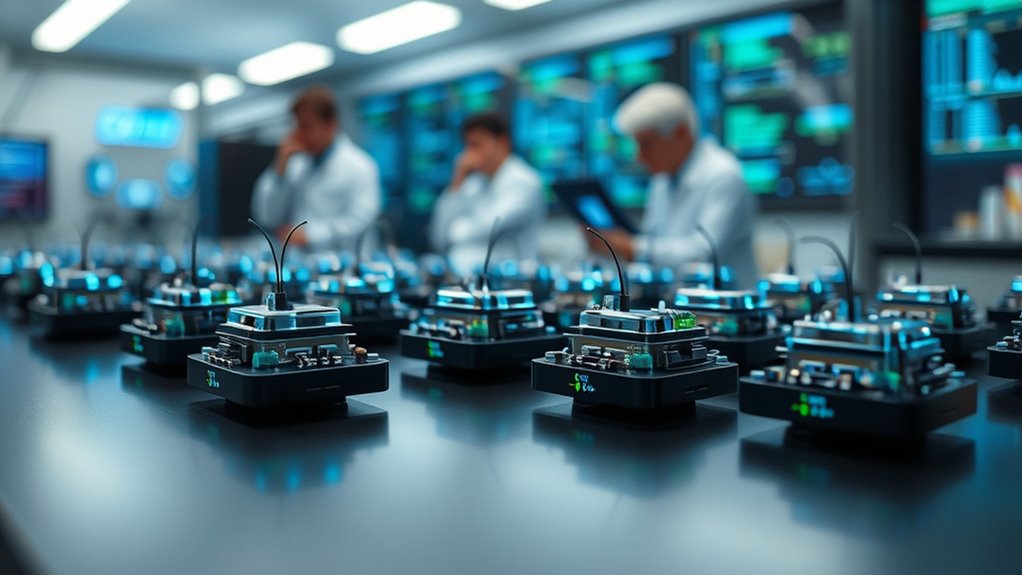
Electronic noses mimic human olfaction by replicating the way our noses detect and interpret odors. When you smell something, your nose’s sensors recognize specific molecules and send signals to your brain, which identifies the scent. Electronic noses use sensors that detect odor molecules in the air, just like human olfactory receptors do. These sensors produce electrical signals based on the chemical properties of the molecules they encounter. The device then processes these signals to identify and differentiate odors. Unlike traditional methods, electronic noses can analyze complex scent profiles quickly and consistently. They simulate the human sense of smell by translating chemical information into digital data, enabling machines to “smell” with precision. This biomimicry forms the foundation for advanced odor detection technology. Hydrocolloid technology enhances the effectiveness of some scent detection methods by maintaining optimal conditions for sensor performance.
Key Technologies Behind Electronic Nose Development
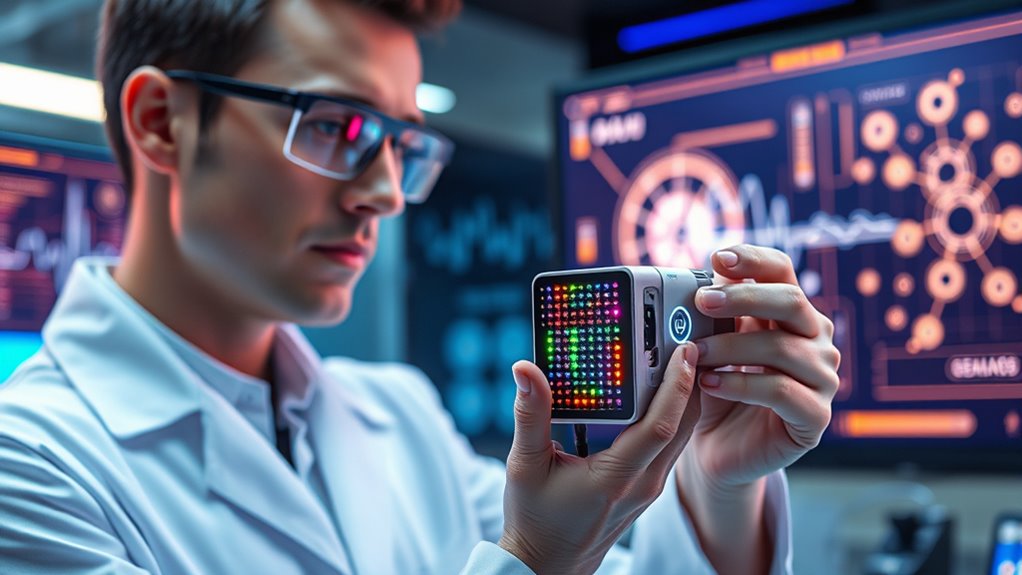
You need reliable sensor array technologies that can detect a wide range of odors with high sensitivity. Pattern recognition algorithms then analyze these signals to identify specific scents accurately. Together, these core technologies enable electronic noses to mimic human olfaction effectively. Incorporating Honda Tuning techniques can also inspire innovative approaches to sensor calibration and system optimization, further advancing electronic nose capabilities.
Sensor Array Technologies
Sensor array technologies form the core of electronic nose development by mimicking the human olfactory system. You use multiple sensors, each sensitive to different chemical properties, to create a unique response pattern for each odor. These sensors can be based on various materials, such as metal oxide semiconductors, conducting polymers, or piezoelectric sensors. As odors interact with the sensors, they produce signals that vary depending on the chemical composition. The array’s diversity allows the system to distinguish among complex scent profiles. You need this variety to capture subtle differences in odors, making the electronic nose more accurate and reliable. Ultimately, sensor array technologies enable electronic noses to analyze complex chemical mixtures with precision similar to biological olfaction.
Pattern Recognition Algorithms
Pattern recognition algorithms are essential for interpreting the complex data generated by sensor arrays in electronic noses. They analyze the signals from sensors, transforming raw data into meaningful patterns that identify specific odors. You’ll use techniques like principal component analysis (PCA) to reduce data complexity, making it easier to visualize and differentiate smells. Machine learning algorithms, such as support vector machines (SVM) or neural networks, help classify odors accurately and improve with experience. These algorithms learn from training data, enhancing detection precision over time. Without them, sensor responses remain meaningless. By applying pattern recognition, you enable your electronic nose to mimic biological olfaction, offering fast, reliable, and automated odor identification tailored to various applications. Materials and techniques used in sensor design and data processing further optimize system performance.
Current Applications and Industry Uses

Electronic noses are already making a difference in various industries. You’ll find them used to guarantee food quality, assist in healthcare diagnostics, and monitor environmental conditions. These applications highlight how versatile and impactful odor detection technology has become today. Additionally, ongoing advancements in sensor accuracy promise even broader capabilities in future developments.
Food Quality Control
Food quality control has become more efficient and reliable thanks to electronic noses, which quickly detect spoilage, contamination, and freshness issues. These devices analyze aroma profiles, ensuring products meet safety standards. They can identify mold, bacteria, or chemical changes that indicate spoilage before visible signs appear. This rapid detection reduces waste and improves consumer safety. Additionally, the high sensitivity to odors allows for precise detection of subtle changes in food aroma profiles. Here’s a visual of how electronic noses compare to traditional methods:
| Traditional Methods | Electronic Nose Detection |
|---|---|
| Time-consuming | Instant results |
| Subjective | Objective readings |
| Requires lab tests | On-site, real-time analysis |
| Less sensitive | High sensitivity to odors |
Healthcare Diagnostic Tools
Healthcare diagnostic tools are transforming medical practices by providing rapid, accurate, and non-invasive methods to detect various conditions. Electronic noses can identify disease biomarkers in breath, sweat, or other samples, offering quick results without the need for blood tests or biopsies. They enable early diagnosis of respiratory illnesses, infections, and metabolic disorders, improving patient outcomes. These devices operate by analyzing complex odor profiles, matching them to known disease signatures. Their portability allows for bedside testing and continuous monitoring, making healthcare more accessible and efficient. As electronic nose technology advances, you’ll see it integrated into routine diagnostics, helping clinicians make faster, more informed decisions. This innovation ultimately reduces costs and enhances patient care through precise, non-invasive detection methods. Beekeepers and beekeeping.
Environmental Monitoring
Advancements in odor detection technology are now making a significant impact on environmental monitoring. Electronic noses enable you to detect pollutants and hazardous gases quickly and accurately, improving air and water quality assessments. Industries use these devices to monitor emissions from factories, ensuring compliance with environmental regulations. They also help identify leaks in pipelines or storage tanks, preventing environmental contamination. In waste management, electronic noses assess odors from landfills and wastewater treatment plants, minimizing community disruption. Additionally, these sensors support emergency response teams by providing rapid detection of toxic or combustible gases, enabling swift action. As the technology advances, you’ll find electronic noses becoming more integrated into routine environmental inspections, offering real-time data and enhancing your ability to protect ecosystems and public health effectively. The integration of advanced sensor technology also allows for more precise detection of specific odor compounds, leading to better source identification and mitigation strategies.
Advances in Sensory Accuracy and Sensitivity
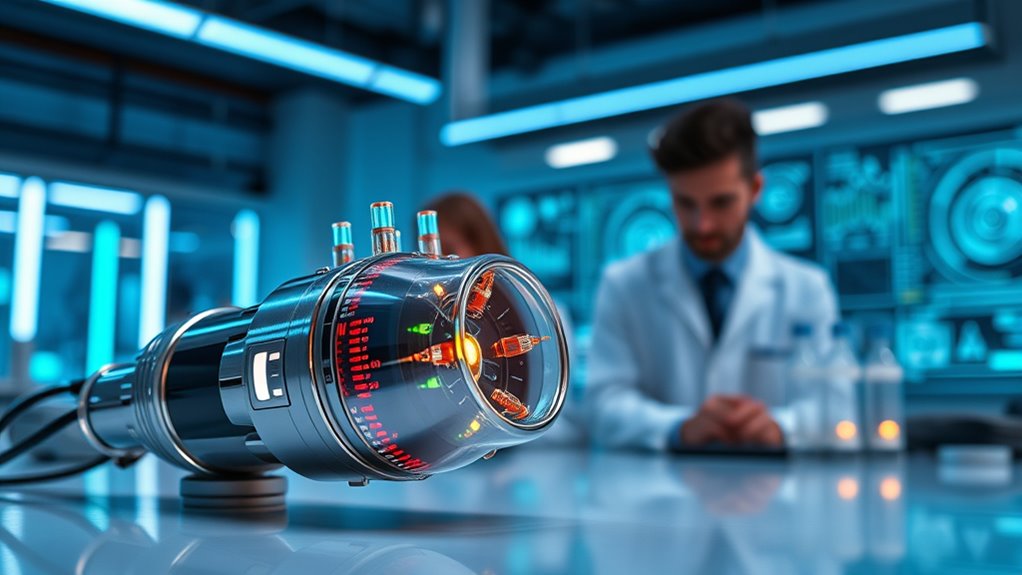
Recent developments have considerably enhanced the sensory accuracy and sensitivity of electronic noses, allowing you to detect even trace amounts of odors with remarkable precision. Advances in sensor materials, such as nanomaterials and bio-inspired compounds, have increased selectivity and reduced noise. Improvements in sensor array design enable better pattern recognition, making it easier to distinguish complex odor profiles. Additionally, new fabrication techniques have produced more stable and durable sensors, ensuring consistent performance over time. These innovations mean your electronic nose can now identify subtle scent differences that were previously undetectable. Control pet hair management techniques highlight the importance of maintaining a clean environment for optimal device performance. As a result, applications like food quality assessment, disease diagnosis, and environmental monitoring benefit from heightened accuracy and sensitivity, providing you with more reliable data and expanding the potential uses of electronic noses in diverse fields.
Integration With Artificial Intelligence and Machine Learning
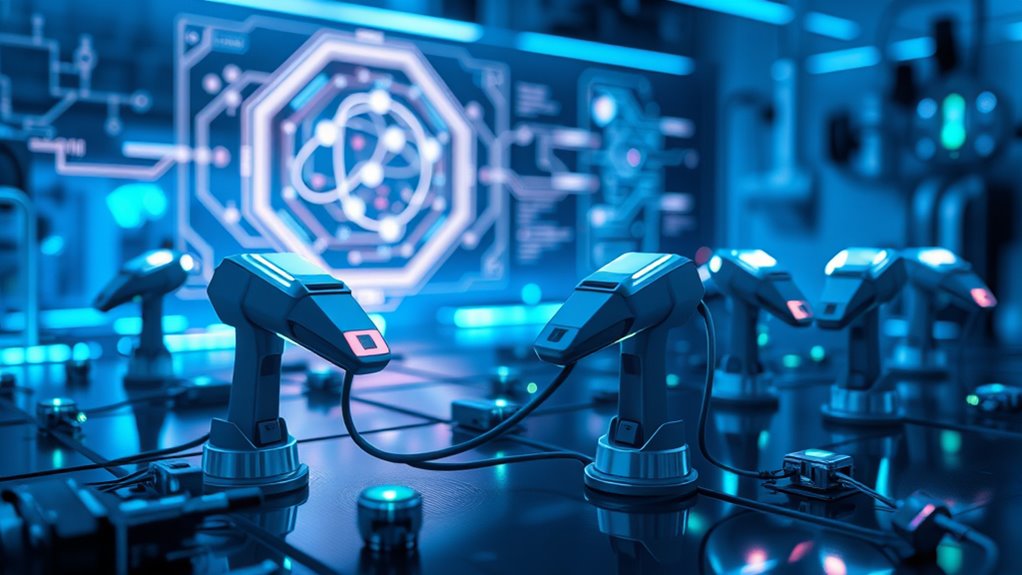
Integrating artificial intelligence and machine learning with electronic noses dramatically enhances their ability to interpret complex odor data. These technologies enable your device to learn from vast datasets, identify patterns, and adapt to new scents over time. As a result, electronic noses become more accurate, faster, and capable of distinguishing subtle differences in odors. Machine learning algorithms analyze sensor signals, reducing false positives and improving reliability. This synergy allows applications like food quality control, environmental monitoring, and medical diagnostics to operate more efficiently. Additionally, knowledge of regional legal resources can facilitate collaborations and compliance with industry standards. Below is a table highlighting key benefits:
| Benefit | Description | Impact |
|---|---|---|
| Improved Accuracy | Better pattern recognition | Fewer false readings |
| Faster Response | Real-time data processing | Quicker decision-making |
| Adaptive Learning | Continuous improvement from data | Enhanced sensitivity |
| Versatility | Handles diverse odor profiles | Broader applications |
| Automation | Reduced manual oversight | Increased efficiency |
Challenges and Limitations Facing Electronic Noses

Despite their promising capabilities, electronic noses face several significant challenges that limit their widespread adoption. One major hurdle is sensor stability; over time, sensors can degrade, causing inconsistent readings. Environmental factors like humidity, temperature fluctuations, and background odors can also interfere with accuracy, making reliable detection difficult. Additionally, developing sensors that can distinguish complex odor mixtures remains challenging, as many scents share overlapping chemical signatures. Calibration and maintenance requirements add to operational costs and complexity. Moreover, creating standardized testing protocols is difficult, hindering comparison across devices. These limitations hinder the deployment of electronic noses in critical fields like healthcare and food safety, where precision is essential. Furthermore, the sensor degradation issue can lead to increased costs and reduced lifespan of devices, complicating long-term usage. Overcoming these obstacles is essential for enabling the full potential of electronic noses in real-world applications.
Future Trends and Potential Innovations
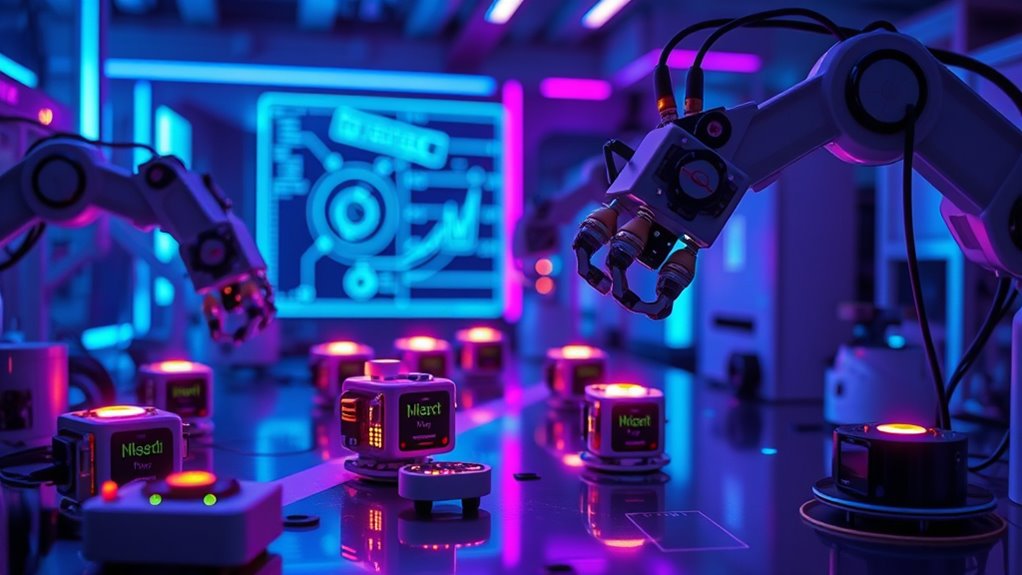
The future of electronic noses is poised for significant advancements driven by emerging technologies and innovative design approaches. You can expect faster, more accurate, and more versatile devices that adapt to various environments. Breakthroughs in nanotechnology, machine learning, and sensor materials will enable electronic noses to detect complex odors with precision. Additionally, integration with IoT will facilitate real-time monitoring across industries.
| Technology | Benefit | Potential Application |
|---|---|---|
| Nanomaterials | Higher sensitivity and durability | Food safety, environmental monitoring |
| AI & Machine Learning | Improved pattern recognition | Medical diagnostics, quality control |
| Miniaturization | Portable, wearable devices | Personal health, safety alerts |
Impact on Daily Life and Global Industries
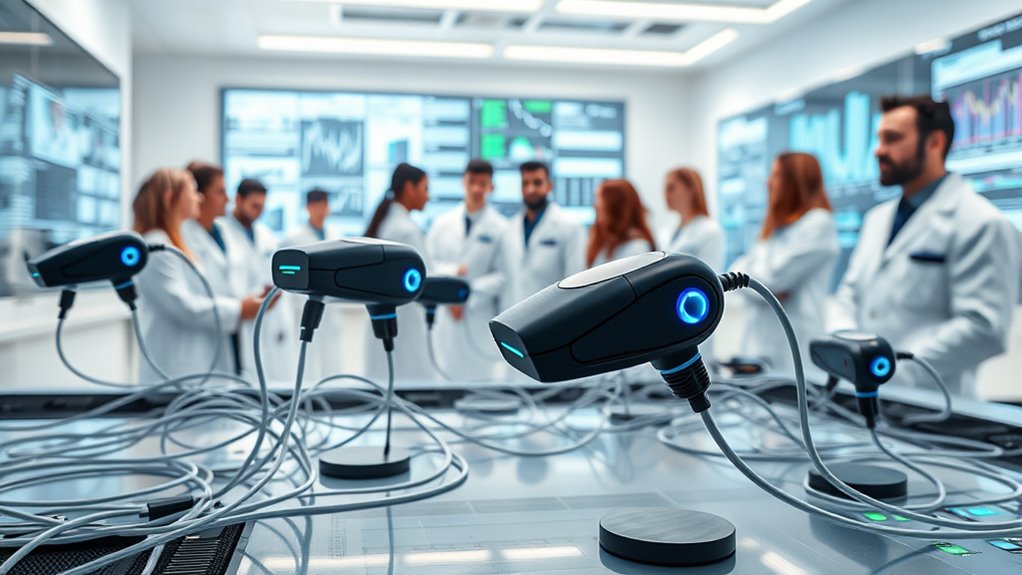
Electronic noses are already transforming daily life and industries by providing rapid, non-invasive odor detection that enhances safety, quality, and convenience. In food production, they ensure freshness and detect spoilage early, reducing waste. In healthcare, they assist in diagnosing diseases through breath analysis, offering faster results. For environmental monitoring, they identify pollutants and hazardous gases quickly, preventing health risks. In retail, they improve product quality control and customer experience. Industries like automotive and manufacturing use electronic noses to detect leaks, contamination, or malfunctions. This technology also helps in security by identifying explosives or illegal substances. As electronic noses become more accurate and affordable, expect them to become integral to your daily routines and industries worldwide, making processes safer, more efficient, and more reliable.
Frequently Asked Questions
How Do Electronic Noses Differentiate Between Similar Odors?
You might wonder how electronic noses tell similar smells apart. They use sensor arrays that detect specific chemical patterns, much like your nose does with olfactory receptors. When exposed to odors, these sensors produce unique electrical signals. The device then compares these signals to a database of known patterns, allowing it to identify and differentiate even closely related scents with high accuracy.
What Materials Are Used to Build Electronic Nose Sensors?
Think of electronic noses as skilled painters choosing their palettes. They use materials like metal oxide semiconductors, conducting polymers, and carbon nanotubes to craft sensitive sensors. These materials act like brushes that catch scent molecules, changing electrical signals. You’ll find them layered on substrates like ceramic or flexible plastics. Together, they form a sophisticated toolkit that detects and differentiates odors, much like an artist capturing subtle shades on a canvas.
How Cost-Effective Are Electronic Noses for Small Businesses?
You might wonder how cost-effective electronic noses are for small businesses. They can be quite affordable compared to traditional detection methods, especially as technology advances and manufacturing costs decrease. You’ll find that electronic noses can provide quick, reliable results, saving you time and money in the long run. While initial investments vary, their ability to detect odors accurately makes them a valuable tool for small businesses aiming to improve quality control and safety.
Can Electronic Noses Detect Hazardous or Toxic Gases Safely?
You ask if electronic noses can detect hazardous or toxic gases safely. They are designed with sensors that identify harmful substances accurately, making them a valuable safety tool. When properly calibrated and maintained, electronic noses can detect dangerous gases early, helping you prevent accidents. While they’re generally safe to use, guarantee you follow manufacturer instructions and regular testing to maximize their reliability and safety in your environment.
What Are the Ethical Considerations in Deploying Electronic Noses?
Imagine a world where your senses are augmented—sounds exciting, right? When deploying electronic noses, you must consider privacy concerns, as these devices may collect sensitive environmental data. You also need to guarantee they’re used ethically, avoiding misuse or bias. Responsible deployment involves transparency, consent, and safeguarding data, so you prevent potential harm. Balancing innovation with ethics ensures these tools serve society without compromising individual rights.
Conclusion
While some might worry electronic noses can’t match human scent detection, ongoing advances in AI and sensor tech prove otherwise. You’ll find these devices becoming more accurate, adaptable, and essential across industries—from food safety to healthcare. Though challenges remain, their potential to revolutionize how you detect and interpret odors is immense. Embracing this technology means you’ll benefit from safer environments, improved diagnostics, and smarter products, making everyday life more convenient and secure.









